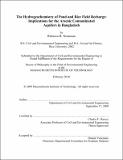| dc.contributor.advisor | Charles F. Harvey. | en_US |
| dc.contributor.author | Neumann, Rebecca B | en_US |
| dc.contributor.other | Massachusetts Institute of Technology. Dept. of Civil and Environmental Engineering. | en_US |
| dc.coverage.spatial | a-bg--- | en_US |
| dc.date.accessioned | 2010-08-26T15:22:56Z | |
| dc.date.available | 2010-08-26T15:22:56Z | |
| dc.date.copyright | 2009 | en_US |
| dc.date.issued | 2010 | en_US |
| dc.identifier.uri | http://hdl.handle.net/1721.1/57548 | |
| dc.description | Thesis (Ph. D.)--Massachusetts Institute of Technology, Dept. of Civil and Environmental Engineering, February 2010. | en_US |
| dc.description | This electronic version was submitted by the student author. The certified thesis is available in the Institute Archives and Special Collections. | en_US |
| dc.description | Cataloged from student submitted PDF version of thesis. Page 290 blank. | en_US |
| dc.description | Includes bibliographical references. | en_US |
| dc.description.abstract | The shallow aquifers in Bangladesh, which provide drinking water for millions and irrigation water for innumerable rice fields, are severely contaminated with geogenic arsenic. Water mass balance calculations show that groundwater-irrigated rice fields and man-made ponds are the primary sources of recharge to the contaminated aquifers. We studied the hydrology and chemistry of these anthropogenic recharge sources to determine the impact they have on groundwater arsenic concentrations. Our hydrogeochemical investigation involved fieldwork, laboratory analyses, and modeling. The field research spanned three years and included the deployment of a sensor network to continually monitor soil moisture and water potential, tracer tests to visualize flow patterns, soil cores to determine soil properties, and soil and water samples to ascertain chemical characteristics. The large amount of generated data were synthesized with hydrologic, geochemical and mass-balance models. The study showed that physical and chemical differences between rice fields and ponds explain the spatial patterns of arsenic in the Bangladeshi aquifers. Recharge from rice fields is both temporally and spatially heterogeneous. It is focused through bunds (the raised boundaries around the perimeter of fields) and depends on irrigation intervals. Flow from ponds is constant and uniform through the pond sediments. These distinct hydrologic behaviors produce different water chemistries. Ponds contribute anoxic recharge elevated in labile organic carbon, while rice fields contribute semi-oxic recharge that lacks labile organic carbon. | en_US |
| dc.description.abstract | (cont.) The labile organic carbon in the pond recharge stimulates microbial respiration that mobilizes sediment-bound arsenic, contributing dissolved arsenic to the aquifers. Conversely, rice-field recharge does not mobilize arsenic. In fact, rice fields act as an arsenic sink. Irrigation moves arsenic-rich groundwater from the aquifers and deposits it on the rice fields. Most of the deposited arsenic does not return to the aquifers; it is sorbed by the field's surface soil and bunds, and is swept away in the monsoon floods. The results demonstrate how land-use changes in Bangladesh have impacted groundwater arsenic concentrations. | en_US |
| dc.description.statementofresponsibility | by Rebecca B. Neumann. | en_US |
| dc.format.extent | 290 p. | en_US |
| dc.language.iso | eng | en_US |
| dc.publisher | Massachusetts Institute of Technology | en_US |
| dc.rights | M.I.T. theses are protected by
copyright. They may be viewed from this source for any purpose, but
reproduction or distribution in any format is prohibited without written
permission. See provided URL for inquiries about permission. | en_US |
| dc.rights.uri | http://dspace.mit.edu/handle/1721.1/7582 | en_US |
| dc.subject | Civil and Environmental Engineering. | en_US |
| dc.title | The hydrogeochemistry of pond and rice field recharge : implications for the arsenic contaminated aquifers in Bangladesh | en_US |
| dc.type | Thesis | en_US |
| dc.description.degree | Ph.D. | en_US |
| dc.contributor.department | Massachusetts Institute of Technology. Department of Civil and Environmental Engineering | |
| dc.identifier.oclc | 639315519 | en_US |
